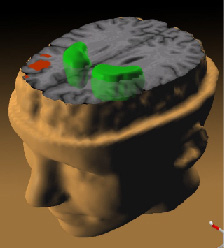
Planning (cognitive)
Encyclopedia

Neuroimaging
Neuroimaging includes the use of various techniques to either directly or indirectly image the structure, function/pharmacology of the brain...
approaches have suggested there is a positive relationship between impaired planning ability and damage to the frontal lobe
Frontal lobe
The frontal lobe is an area in the brain of humans and other mammals, located at the front of each cerebral hemisphere and positioned anterior to the parietal lobe and superior and anterior to the temporal lobes...
.
A specific area within the mid-dorsolateral frontal cortex located in the frontal lobe has been implicated as playing an intrinsic role in both cognitive planning and associated executive traits such as working memory
Working memory
Working memory has been defined as the system which actively holds information in the mind to do verbal and nonverbal tasks such as reasoning and comprehension, and to make it available for further information processing...
.
Disruption of the neural pathway
Neural pathway
A neural pathway, neural tract, or neural face, connects one part of the nervous system with another and usually consists of bundles of elongated, myelin-insulated neurons, known collectively as white matter...
s, via various mechanisms such as traumatic brain injury
Traumatic brain injury
Traumatic brain injury , also known as intracranial injury, occurs when an external force traumatically injures the brain. TBI can be classified based on severity, mechanism , or other features...
, or the effects of neurodegenerative diseases between this area of the frontal cortex and the basal ganglia
Basal ganglia
The basal ganglia are a group of nuclei of varied origin in the brains of vertebrates that act as a cohesive functional unit. They are situated at the base of the forebrain and are strongly connected with the cerebral cortex, thalamus and other brain areas...
specifically the striatum
Striatum
The striatum, also known as the neostriatum or striate nucleus, is a subcortical part of the forebrain. It is the major input station of the basal ganglia system. The striatum, in turn, gets input from the cerebral cortex...
(cortico-striatal pathway), may disrupt the processes required for normal planning function.
Individuals who were born Very Low Birth Weight (<1500 grams) and Extremely Low BirthWeight (ELBW) are at greater risk for various cognitive deficits including planning ability.
Neuropsychological Tests

- Tower of HanoiTower of HanoiThe Tower of Hanoi or Towers of Hanoi, also called the Tower of Brahma or Towers of Brahma, is a mathematical game or puzzle. It consists of three rods, and a number of disks of different sizes which can slide onto any rod...
(TOH-R), a puzzle invented in 1883 by the French mathematician Édouard Lucas. There are different variations of the puzzle, the classic version consists of three rods and usually seven to nine discs of subsequently smaller size. Planning is a key component of the problem solving skills necessary to achieve the objective, which is to move the entire stack to another rod, obeying the following rules:- Only one disk may be moved at a time.
- Each move consists of taking the upper disk from one of the rods and sliding it onto another rod, on top of the other disks that may already be present on that rod.
- No disk may be placed on top of a smaller disk.
- Tower of LondonTower of London TestThe Tower of London test is a well-known test used in applied clinical neuropsychology for the assessment of executive functioning specifically to detect deficits in planning, which may occur due to a variety of medical and neuropsychiatric conditions...
(TOL) is another test that was developed in 1992 (Shallice 1992) specifically to detect deficits in planning as may occur with damage to the frontal lobe. test participants with damage to the left anterior frontal lobe demonstrated planning deficits (i.e., greater number of moves required for solution).
In test participants with damage to the right anterior, and left or right posterior areas of the frontal lobes showed no impairment. The results implicating the left anterior frontal lobes involvement in solving the TOL were supported in concomitant neuroimaging studies which also showed a reduction in regional cerebral blood flow
Cerebral blood flow
Cerebral blood flow, or CBF, is the blood supply to the brain in a given time. In an adult, CBF is typically 750 millitres per minute or 15% of the cardiac output. This equates to 50 to 54 millilitres of blood per 100 grams of brain tissue per minute. CBF is tightly regulated to meet the brain's...
to the left pre-frontal lobe. For the number of moves, a significant negative correlation was observed for the left prefrontal area: i.e. subjects that took more time planning their moves showed greater activation in the left prefrontal area.

